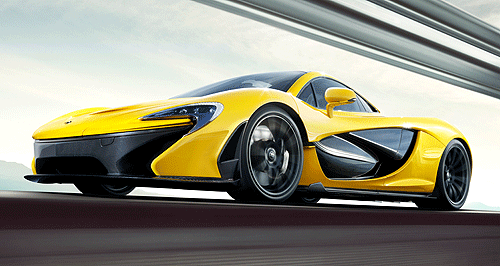Future models - McLaren - P1Geneva show: McLaren P1 blasts to 300km/h in 17sElectrical storm: The McLaren P1 can use its combination of twin-turbo V8 power and electrical assistance to deliver searing acceleration. More staggering statistics on McLaren P1 hypercar emerge ahead of Geneva debut27 Feb 2013 MCLAREN claims its hybrid P1 hypercar can accelerate to 100km/h in less than three seconds, reach 200km/h in under seven seconds and on to 300km/h in less than 17 seconds. Similarly staggering is the starting price, its £866,000 ($A1.3 million) sticker likely to balloon to around $A2m in Australia once luxury car tax and other imposts are taken into account. Just 375 P1s will be built, all in left-hand-drive, meaning the flagship McLaren will not be registrable for road use in Australia – but there is nothing stopping people buying one as a collector’s item or track toy. That 0-300km/h figure is five seconds – or 23 per cent – faster than the iconic McLaren F1 to which the P1 is spiritual successor, but its top speed stops short of the F1’s record-setting 390km/h, with an electronic nanny stepping in at 350km/h. For round-town use, the P1 is claimed to offer up to 20km of pure electric range at an average speed of 48km/h. Specially developed Pirelli P Zero Corsa tyres help put the plug-in petrol-electric drivetrain’s 673kW and 900Nm to the ground, while delivering the grip, traction and handling befitting this track-ready road rocket. McLaren says the P1’s standard specification “fully equips the car for both road and track use”, with an options list limited to bespoke personalisation services through McLaren Special Operations and fitted luggage. Braking specialist Akebono – McLaren’s Formula 1 partner – helped develop a new type of carbon ceramic rotor for the P1 that is lighter, stronger and more thermally efficient than standard carbon ceramic items. Using technology previously used for space travel, it is the first time a braking system of its type used on a road car and gives the friction surfaces a unique mirrored finish that can be seen through the alloy wheel spokes. Compared with the design study shown at the Paris motor show last September, the production P1 has only one significant styling change – extra cooling ducts in front of the front wheels that also improve downforce. McLaren says customer and media response to the P1 design study at Paris delivered a “unanimous verdict” that the car’s styling should not change. As reported, the P1 deploys a mid-mounted 3.8-litre twin-turbo V8 petrol engine developed from that used in the MP4-12C supercar, producing 542kW and 720Nm alone and assisted by a 131kW/260Nm electric motor that feeds the rear wheels via a seven-speed dual-clutch transmission. Energy for the electric motor comes from a lightweight lithium battery pack that can be fully charged in around two hours. As reported, McLaren says the P1’s CO2 emissions come in at less less than 200 grams per kilometre, translating to fuel consumption in the region of 8.5 litres per 100km. In other words, the P1 delivers true hypercar performance yet has similar fuel consumption to a small hatchback. Formula 1 derived technologies include active aerodynamics that reduce drag for bursts of straight-line speed, combined with an Intelligent Power Assist System that provides an instant burst of power from the electric motor when required.  Read more21st of February 2013  Geneva show: McLaren’s electrifying P1 statsMcLaren P1 supercar to pack a 673kW/900Nm plug-in hybrid powertrain13th of February 2013  McLaren P1 interior takes shapeCarbon-fibre and no interior sound deadening ensure McLaren P1 keeps weight downAll future models Alfa Romeo Alfa Romeo Abarth Abarth Alpine Alpine Alpina Alpina Audi Audi Aston Martin Aston Martin BMW BMW Bentley Bentley Chery Chery Brabham Brabham Chrysler Chrysler Chevrolet Chevrolet Cupra Cupra Citroen Citroen DS DS Dodge Dodge Fiat Fiat Ferrari Ferrari Foton Foton Ford Ford Great Wall Great Wall FPV FPV Haval Haval GWM GWM Honda Honda Holden Holden Hummer Hummer HSV HSV Infiniti Infiniti Hyundai Hyundai Jaguar Jaguar Isuzu Isuzu Kia Kia Jeep Jeep Land Rover Land Rover Lamborghini Lamborghini Lexus Lexus LDV LDV Mahindra Mahindra Lotus Lotus Mazda Mazda Maserati Maserati Mercedes-AMG Mercedes-AMG McLaren McLaren MG MG Mercedes-Benz Mercedes-Benz Mitsubishi Mitsubishi Mini Mini Opel Opel Nissan Nissan Peugeot Peugeot Pagani Pagani Proton Proton Porsche Porsche Renault Renault Ram Ram Rover Rover Rolls-Royce Rolls-Royce Skoda Skoda Saab Saab SsangYong SsangYong Smart Smart Suzuki Suzuki Subaru Subaru Toyota Toyota Tesla Tesla Volvo VolvoMotor industry news |
Click to shareMcLaren modelsResearch McLaren All future models Alfa Romeo Alfa Romeo Abarth Abarth Alpine Alpine Alpina Alpina Audi Audi Aston Martin Aston Martin BMW BMW Bentley Bentley Chery Chery Brabham Brabham Chrysler Chrysler Chevrolet Chevrolet Cupra Cupra Citroen Citroen DS DS Dodge Dodge Fiat Fiat Ferrari Ferrari Foton Foton Ford Ford Great Wall Great Wall FPV FPV Haval Haval GWM GWM Honda Honda Holden Holden Hummer Hummer HSV HSV Infiniti Infiniti Hyundai Hyundai Jaguar Jaguar Isuzu Isuzu Kia Kia Jeep Jeep Land Rover Land Rover Lamborghini Lamborghini Lexus Lexus LDV LDV Mahindra Mahindra Lotus Lotus Mazda Mazda Maserati Maserati Mercedes-AMG Mercedes-AMG McLaren McLaren MG MG Mercedes-Benz Mercedes-Benz Mitsubishi Mitsubishi Mini Mini Opel Opel Nissan Nissan Peugeot Peugeot Pagani Pagani Proton Proton Porsche Porsche Renault Renault Ram Ram Rover Rover Rolls-Royce Rolls-Royce Skoda Skoda Saab Saab SsangYong SsangYong Smart Smart Suzuki Suzuki Subaru Subaru Toyota Toyota Tesla Tesla Volvo VolvoMotor industry news |
























Facebook Twitter Instagram